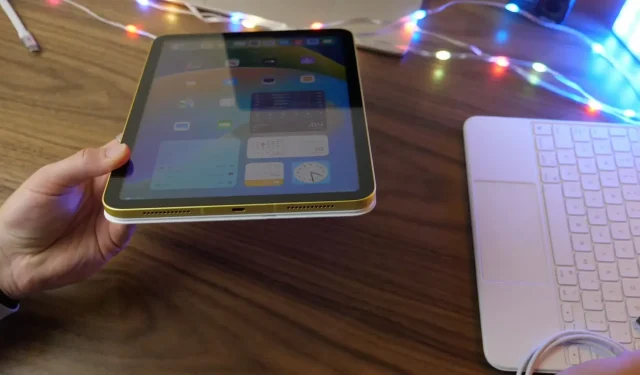The new $449 iPad’s USB-C port offers the same (slow) USB 2.0 data transfer speeds as its Lightning-based ninth-generation predecessor.
- What is happening? Despite the USB-C port, the new tenth generation iPad transfers data at speeds up to 480 Mbps – just like its Lightning-based predecessor.
- Why care? Apple withheld this important information, misleading some buyers who didn’t expect the device’s USB-C port to be slow.
- What to do? If you transfer a lot of data between your iPad and your computer, it might make more sense to buy an iPad mini or iPad Air instead.
How fast is the USB-C port on iPad 10?
Despite having a USB-C port, the tenth generation iPad is limited to the same USB 2.0 speeds as its Lightning-based ninth generation predecessor.
This translates to data transfer rates of up to 480 Mbps for the iPad 10, which equates to approximately sixty megabytes per second. Now the latest version 3.1 of the USB-C protocol is capable of transferring data at speeds up to 10 Gbps, which is about 1250 megabytes per second (or 1.25 gigabytes per second).
But the new iPad can only dream of such numbers.
USB-C performance on other iPads
In comparison, the latest iPad Air M1 supports data transfer rates up to 10Gbps via a USB-C connection. iPad mini with the A15 Bionic processor offers speeds up to 5 Gbps (about 625 megabytes per second) through the USB-C port.
Apple didn’t specify that the new iPad’s USB-C port is actually USB 2.0 speed-limited. If it wasn’t for Dan Seifert of The Verge, we’d still be in the dark because Apple’s iPad specs page doesn’t mention it either.
Another fun fact: The iPad 10’s USB-C port supports 4K 30Hz or 1080p 60Hz external displays. It will not output 4K video at sixty frames per second.
At least Apple could have kept the headphone jack.
Why is the USB-C port on iPad 10 slower than other iPads?
It’s most likely due to the processor. Not all Apple chips are the same. For example, the M1 found on the fifth generation iPad supports full USB-C 3.1 data transfer rates up to 10Gbps. By comparison, the iPad 10 runs on Apple’s A14 Bionic chip.
On the other hand, the M1 and M2 chips used in the iPad Pro support Thunderbolt 3 for data transfer rates up to 40Gbps – or about five gigabytes per second.
Can a software update fix this?
No, It is Immpossible. Some Apple chips only support USB-C, while others also support Thunderbolt I/O.
As a closed computer, the iPad doesn’t support swapping the CPU, RAM, and other components, so you’re stuck with what you have. In short, don’t count on a future iOS software update that will improve USB-C transfer speeds on the iPad 10.


